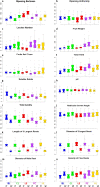Genome wide association mapping for agronomic, fruit quality, and root architectural traits in tomato under organic farming conditions
- PMID: 34686145
- PMCID: PMC8532347
- DOI: 10.1186/s12870-021-03271-4
Genome wide association mapping for agronomic, fruit quality, and root architectural traits in tomato under organic farming conditions
Abstract
Background: Opportunity and challenges of the agriculture scenario of the next decades will face increasing demand for secure food through approaches able to minimize the input to cultivations. Large panels of tomato varieties represent a valuable resource of traits of interest under sustainable cultivation systems and for genome-wide association studies (GWAS). For mapping loci controlling the variation of agronomic, fruit quality, and root architecture traits, we used a heterogeneous set of 244 traditional and improved tomato accessions grown under organic field trials. Here we report comprehensive phenotyping and GWAS using over 37,300 SNPs obtained through double digest restriction-site associated DNA (dd-RADseq).
Results: A wide range of phenotypic diversity was observed in the studied collection, with highly significant differences encountered for most traits. A variable level of heritability was observed with values up to 69% for morphological traits while, among agronomic ones, fruit weight showed values above 80%. Genotype by environment analysis highlighted the strongest genotypic effect for aboveground traits compared to root architecture, suggesting that the hypogeal part of tomato plants has been a minor objective for breeding activities. GWAS was performed by a compressed mixed linear model leading to 59 significantly associated loci, allowing the identification of novel genes related to flower and fruit characteristics. Most genomic associations fell into the region surrounding SUN, OVATE, and MYB gene families. Six flower and fruit traits were associated with a single member of the SUN family (SLSUN31) on chromosome 11, in a region involved in the increase of fruit weight, locules number, and fruit fasciation. Furthermore, additional candidate genes for soluble solids content, fruit colour and shape were found near previously reported chromosomal regions, indicating the presence of synergic and multiple linked genes underlying the variation of these traits.
Conclusions: Results of this study give new hints on the genetic basis of traits in underexplored germplasm grown under organic conditions, providing a framework for the development of markers linked to candidate genes of interest to be used in genomics-assisted breeding in tomato, in particular under low-input and organic cultivation conditions.
Keywords: Genome-wide association mapping; Genotype by environment; Organic farming; Phenotyping; Tomato.
© 2021. The Author(s).
Conflict of interest statement
The authors declare that they have no competing interests.
Figures









Similar articles
-
GWAS Based on RNA-Seq SNPs and High-Throughput Phenotyping Combined with Climatic Data Highlights the Reservoir of Valuable Genetic Diversity in Regional Tomato Landraces.Genes (Basel). 2020 Nov 23;11(11):1387. doi: 10.3390/genes11111387. Genes (Basel). 2020. PMID: 33238469 Free PMC article.
-
Exploring a Tomato Landraces Collection for Fruit-Related Traits by the Aid of a High-Throughput Genomic Platform.PLoS One. 2015 Sep 22;10(9):e0137139. doi: 10.1371/journal.pone.0137139. eCollection 2015. PLoS One. 2015. PMID: 26393929 Free PMC article.
-
Exploration of a Resequenced Tomato Core Collection for Phenotypic and Genotypic Variation in Plant Growth and Fruit Quality Traits.Genes (Basel). 2020 Oct 29;11(11):1278. doi: 10.3390/genes11111278. Genes (Basel). 2020. PMID: 33137951 Free PMC article.
-
The genetic basis of fruit morphology in horticultural crops: lessons from tomato and melon.J Exp Bot. 2014 Aug;65(16):4625-37. doi: 10.1093/jxb/eru017. Epub 2014 Feb 11. J Exp Bot. 2014. PMID: 24520021 Review.
-
Trait discovery and editing in tomato.Plant J. 2019 Jan;97(1):73-90. doi: 10.1111/tpj.14152. Epub 2018 Dec 24. Plant J. 2019. PMID: 30417464 Review.
Cited by
-
Phenotypic and Genotypic Diversity of the Tomato Germplasm From the Lazio Region in Central Italy, With a Focus on Landrace Distinctiveness.Front Plant Sci. 2022 Jul 22;13:931233. doi: 10.3389/fpls.2022.931233. eCollection 2022. Front Plant Sci. 2022. PMID: 35937347 Free PMC article.
-
Genomic prediction of morphometric and colorimetric traits in Solanaceous fruits.Hortic Res. 2022 Mar 23;9:uhac072. doi: 10.1093/hr/uhac072. eCollection 2022. Hortic Res. 2022. PMID: 35669711 Free PMC article.
-
Crop Landraces and Indigenous Varieties: A Valuable Source of Genes for Plant Breeding.Plants (Basel). 2024 Mar 7;13(6):758. doi: 10.3390/plants13060758. Plants (Basel). 2024. PMID: 38592762 Free PMC article. Review.
-
An integrated genomic and biochemical approach to investigate the potentiality of heirloom tomatoes: Breeding resources for food quality and sustainable agriculture.Front Plant Sci. 2023 Jan 4;13:1031776. doi: 10.3389/fpls.2022.1031776. eCollection 2022. Front Plant Sci. 2023. PMID: 36684727 Free PMC article.
-
A physical map of traits of agronomic importance based on potato and tomato genome sequences.Front Genet. 2023 Jul 25;14:1197206. doi: 10.3389/fgene.2023.1197206. eCollection 2023. Front Genet. 2023. PMID: 37564870 Free PMC article. Review.
References
-
- Anderson R, Bayer PE, Edwards D. Climate change and the need for agricultural adaptation. Curr Opin Plant Biol. 2020;56:197–202. - PubMed
-
- Le Campion A, Oury FX, Heumez E, Rolland B. Conventional versus organic farming systems: dissecting comparisons to improve cereal organic breeding strategies. Org Agr. 2020;10:63–74.
-
- The World of Organic Agriculture In: Statistics Sessions at BIOFACH 2020 Nürnberg, Germany. 2020. https://www.organic-world.net/yearbook/yearbook-2020.html. Accessed 20 June 2021.
-
- FAOSTAT 2019. http://www.fao.org/faostat/en/#home. Accessed 20 June 2021.
-
- Higashide T, Heuvelink E. Physiological and morphological changes over the past 50 years in yield components in tomato. J Am Soc Hortic Sci. 2009;134:460–465.
Publication types
MeSH terms
LinkOut - more resources
Full Text Sources

